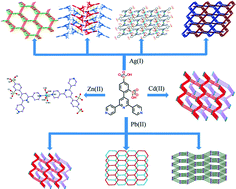Syntheses, structures, and properties of nine d10 or p-block coordination polymers based on a ligand containing both terpyridyl and sulfo groups†
Abstract
Nine new coordination compounds, namely, {[Zn(HDSPTP)2(H2O)4]·6H2O}n (H2DSPTP = 4′-(2,4-disulfophenyl)-4,2′:6′,4′′-terpyridine, (1), [Cd(DSPTP)(H2O)2]n (2), {[Ag(HDSPTP)]·30H2O}n (3), {[Ag(HDSPTP)(H2O)]·3H2O}n (4), [Ag2(DSPTP)]n (5), {[Ag4(DSPTP)2(H2O)3]·2H2O}n (6), [Pb(DSPTP)(H2O)2]n (7), {[Pb(DSPTP)(H2O)3]·3H2O}n (8), and [PbK(DSPTP)(NO3)(H2O)2]·H2O}n (9), were synthesized by introducing a ligand with both terpyridyl and sulfo groups as organic linkers. The reaction of H2DSPTP with Zn(II) salts only resulted in a mononuclear complex (compound 1), in which most donor groups appear uncoordinated, whereas the reaction with Cd(II) salts under similar conditions resulted in a three-dimensional (3D) twofold interpenetrated dia framework (compound 2). The reactions of H2DSPTP with AgCF3CO2 or AgNO3 resulted in compounds 3–6 with different structures: a porous supramolecular framework via interlaced packing of one-dimensional (1D) coordination chains (compound 3), a two-dimensional (6,3) network based on coordination bonds and Ag⋯O interactions (compound 4), a 3D framework based on 1D [Ag2(2-SO3−)2]n secondary building blocks (compound 5), and a twofold interpenetrated framework with a binodal (4,6)-connected fsh topology based on planar tetranuclear SBUs as nodes (compound 6). The reactions of H2DSPTP with Pb(NO3)2 resulted in the following three compounds: a 3D twofold interpenetrated dia framework (complex 7), a twofold interpenetrated (6,3) network (compound 8), and a 3D complicated framework based on tetranuclear SBUs, double-bridge DSPTP2− ligands, and [K(H2O)]+ species (compound 9). The structural diversity is mainly attributed to the rich coordination behaviors of the HDSPTP−/DSPTP2− ligands and the metal center and can be controllably synthesized by altering the metal to ligand ratio, added alkali, and the pH value for the Ag(I) and Pb(II) compounds. Compound 2 exhibits a high thermal stability above 500 °C, undergoes a crystalline–amorphous–crystalline phase transition as temperature is increased from 25 °C to 500 °C, and shows an amorphous–crystalline phase transition when rehydrated. Moreover, the luminescence properties of all the compounds were also investigated.


 Please wait while we load your content...
Please wait while we load your content...